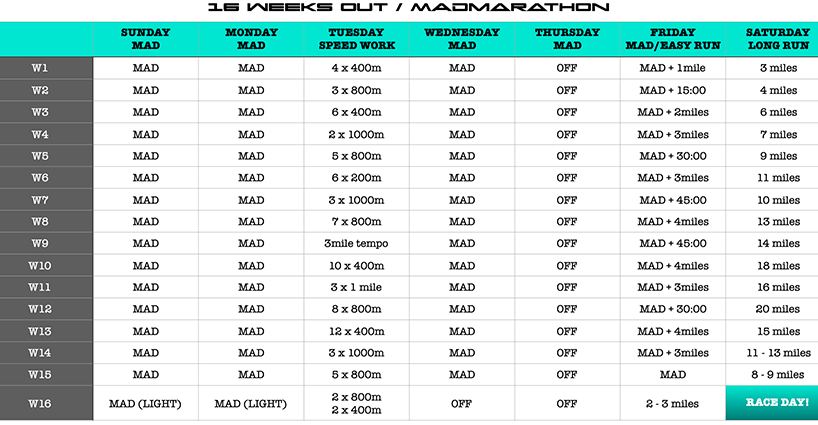The verdict is in: strength training is a critical supplement to the avid runner’s roadwork.
Whether you’re a die hard 10k’er, training for your first half marathon or your 10th full marathon, including a strength-driven routine will only benefit your running results.
Since we are primarily in the business of strength training, if you’re a passionate runner, you might naturally question our authority on this subject.
Well…in addition to the overwhelming number of testimonials we receive from clients who competitively run and cross train with us at MAD, we figured we’d turn to an expert within the MAD family: Tricia Thompson.
Tricia – at the youthful age of 32 – has already run 37 full marathons in her lifetime.
Not a typo. You read that correctly. Thirty. Seven. Marathons. Insert mind-blown emoji here.
Tricia is also a trainer at MADabolic Arlington and H-Street and complements her running routine with a regular strength training schedule in the MADhouse…and the results speak for themselves.
“As a lifelong runner, I was a true skeptic when I was first introduced to lifting heavy. I definitely fell into the category of the endurance athlete that felt I’d get better by simply running more. I was afraid of bulking up and thought heavy weights were counterproductive to marathon training. But with a little (or a lot) of convincing, I continued to increase my strength training frequency as well as the weights I was lifting, and — low and behold — my marathons got easier and faster!”
This fear of strength training that Tricia initially grappled with seems to be VERY real in the running world.
“What will the added mass to do my times? Won’t it slow me down? To get better at running, it seems like I should just run more!”
Well for starters – whether you’re brand new to running or a seasoned vet, attacking any distance that is challenging for you will require milage. But this doesn’t need to come with the sacrifice of cross training.
On the contrary, here’s WHY strength training may favorably impact your running goals:
- Heightened balance and coordination (important for stride efficiency)
- Improved speed and power (consider this in relation to varying terrains and hills)
- Improved VO2 max
- Lessened muscular fatigue over long distances
- Injury prevention and improved recovery through stronger muscles and connective tissue
- Improved bone health and joint protection
- So how exactly do you include a MAD routine in tandem with your running training?
Take a look at our proposed “16-week out” schedule at the top. We designed this sample schedule with full marathon trainees in mind.
Three things to emphasize with this roadmap:
- This plan is generalized, and more so geared towards those of you who have a goal of completion (rather than competition).
- This is great for 2 types of runners – those that have been doing MAD consistently and want to add in running for the first time, OR those that have been running consistently and want to start MAD regularly. If you’re fairly new to fitness or green in either area, you’d want to tone it down a bit and take more rest days. Additionally, you may want to avoid doubling up on Fridays knowing that your long run falls on Saturday (especially if an anaerobic interval falls on this day).
- If you’re going to follow a plan like this, you should also be following our (free) Nutrition Blueprint to ensure that you’re fueling properly (available for download directly on our website).
In short, if you’re serious about upping your running game, we implore you to identify a schedule that enables some level of complementary strength training – whether that be at MADabolic or elsewhere.
As Tricia puts it: “Strength training has been an absolute game changer in my distance running.” In fact, over the course of the last year, Tricia has actually cut down on her mileage — even while training for full marathons — in favor of adding more MADabolic training to her routine. In turn, she’s experienced incredible improvements in her running. “Not only are my splits getting significantly faster,” she confirms, “but my recovery takes a fraction of the time it used to, my body composition has entirely changed (for the better), and I physically just feel fantastic overall!”



